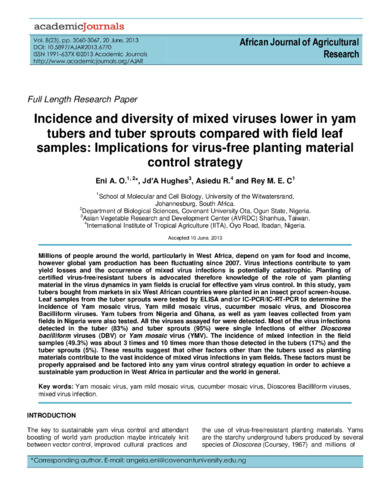Incidence and diversity of mixed viruses lower in yam tubers and tuber sprouts compared with field leaf samples: Implications for virusfree planting material control strategy
Abstract
Millions of people around the world, particularly in West Africa, depend on yam for food and income, however global yam production has been fluctuating since 2007. Virus infections contribute to yam yield losses and the occurrence of mixed virus infections is potentially catastrophic. Planting of certified virus-free/resistant tubers is advocated therefore knowledge of the role of yam planting material in the virus dynamics in yam fields is crucial for effective yam virus control. In this study, yam tubers bought from markets in six West African countries were planted in an insect proof screen-house. Leaf samples from the tuber sprouts were tested by ELISA and/or IC-PCR/IC-RT-PCR to determine the incidence of Yam mosaic virus, Yam mild mosaic virus, cucumber mosaic virus, and Dioscorea Bacilliform viruses. Yam tubers from Nigeria and Ghana, as well as yam leaves collected from yam fields in Nigeria were also tested. All the viruses assayed for were detected. Most of the virus infections detected in the tuber (83%) and tuber sprouts (95%) were single infections of either Dioscorea bacilliform viruses (DBV) or Yam mosaic virus (YMV). The incidence of mixed infection in the field samples (49.3%) was about 3 times and 10 times more than those detected in the tubers (17%) and the tuber sprouts (5%). These results suggest that other factors other than the tubers used as planting materials contribute to the vast incidence of mixed virus infections in yam fields. These factors must be properly appraised and be factored into any yam virus control strategy equation in order to achieve a sustainable yam production in West Africa in particular and the world in general.

